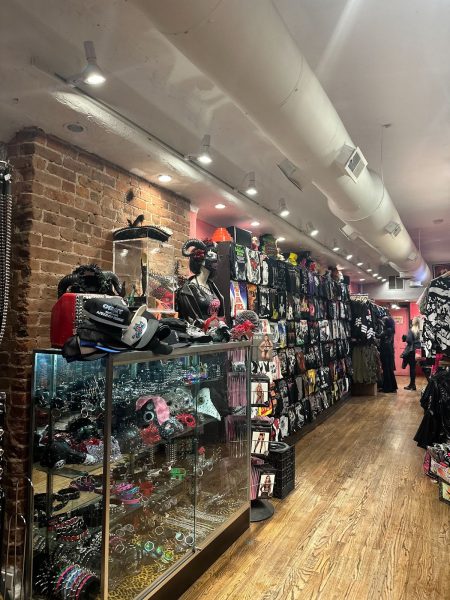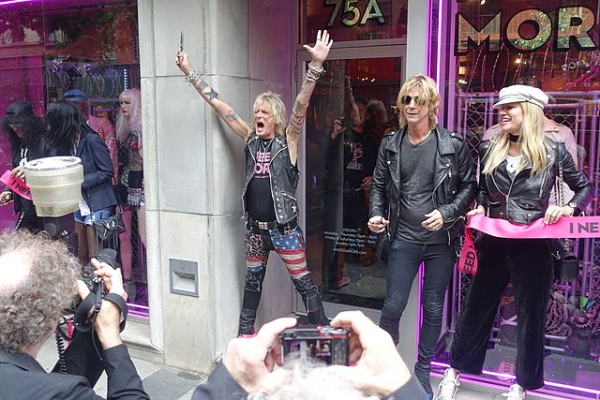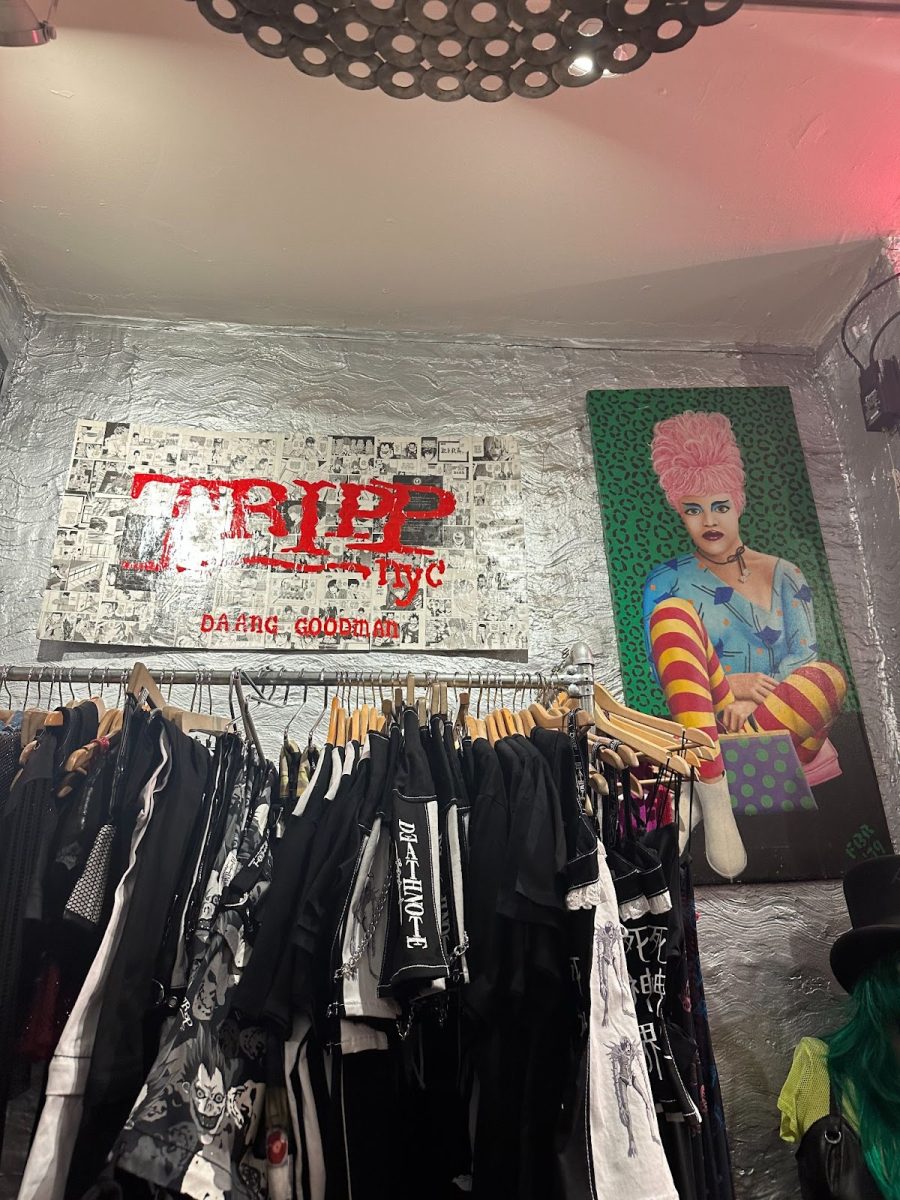In the 1960s, an artistic rejection of social norms, known as counterculture, hit New York City at full speed. As hippies and artists flooded into one of the world’s most vibrant and lively cities, they accumulated in a neighborhood widely famous for its art scene: the East Village. One street in particular nourished an irreplaceable punk culture that thrived on alternative music, grunge fashion, and social rebellion. Saint Marks Place, stretching from Third Avenue to Avenue A, held the businesses and legacies that catered to punk rock’s heavy influence in American culture throughout the late 20th century.
For 41 years, 4 Saint Marks Place was the home of Trash and Vaudeville, a legendary punk clothing store, frequently visited by some of the most adored musicians of the ’70s and ’80s. From Patti Smith and Iggy Pop to members of the Blondie, The Ramones and The Clash, Trash and Vaudeville was the go-to spot for those looking to get a pair of black skinny jeans or Doc Marten boots. However, following the unfortunate gentrification of both the East Village and Saint Marks Place, Trash and Vaudeville moved to 96 E 7th Street in 2016.
While its original location is where the store created a loyal clientele, 4 Saint Marks Place did not always bear the name ‘Trash and Vaudeville.’ In the 1830s, the federal style townhouse was referred to as the ‘Hamilton-Holly House’. It was inhabited by Alexander Hamilton’s widow, Elizabeth Schuyler Hamilton, along with her children for roughly a decade. In the 1840s, as the Hamiltons migrated out of the area, the East Village experienced a large rush of German and Irish immigrants. With countless tenements developed in the area to compensate for the population influx, Saint Marks Place was one of the only streets spared from such brutal developments. Many of the original federal homes were well preserved and remain on the street to this day.
In the years succeeding World War Two and the Great Depression, the area around Saint Marks Place had difficulty rebounding from the era’s economic downturn. However, the new name “East Village” and the reputation of cheap housing brightened the area’s prospects. In the late 1960s, as Abbie Hoffman and Jerry Rubin established the Youth International Party (Yippies) out of a basement on Saint Marks Place, the venture of countless hippies and counterculture activists to the area was inevitable. Ultimately, in the subsequent decades, thousands of artists – both local and acclaimed – migrated to the area, looking for an affordable place to live amidst such a vibrant culture.
“We would break for lunch and go to these little hole in the wall cafes,” said Lauren Seikaly, an actress who worked on Saint Mark’s Place in the ’80s and ’90s. “There were always people writing in journals, and that’s why you got the sense that that was where the artists were hanging out.”
In 1966, Andy Warhol took over the Dom, a Polish restaurant on Saint Marks Place, and transformed it into a nightclub. The Dom housed Warhol’s multimedia event, the Exploding Plastic Inevitable, with The Velvet Underground as its house band. In 1967 the space morphed into the notorious Electric Circus, where patrons were invited to “play games, dress as they like, dance, sit, think, tune in and turn on.” In addition to the Electric Circus, the soon-to-be Trash and Vaudeville was surrounded by CBGB, The Five Spot and Fillmore, some of the hippest nightclubs at the time.
Music, the ultimate backbone of life on Saint Marks Place, was virtually intertwined with fashion. “Clothing and fashion, was another form of expression, like music like rock and roll. It seemed to go hand in hand,” said Trash and Vaudeville’s perpetual owner, Ray Goodman to Rock Scene Magazine.
Ray Goodman came to New York City for the first time in 1972 to see an off-Broadway production of Man of La Mancha. Unable to resist the city’s ambiance, he returned to Saint Marks Place time and time again. Buying various posters or outfit staples which he would sell to his friends back home in Jersey City, his career in marketing began at the age of thirteen.
Years later, after graduating Manhattan’s Fashion Institute of Technology with a degree in buying and merchandising, Goodman began working at the Limbo, a second hand store located at 4 Saint Marks Place. After Limbo closed its doors in 1975, Goodman purchased the building, giving way to Trash and Vaudeville. The store’s niche name arose from Goodman being asked the frequent question, “What’s that trash you’re wearing?” He also liked how the two words sounded together.
“I loved rock ’n’ roll,” Goodman told the New York Times in 2013, “but I wasn’t a good enough drummer to make it in a band. I had to figure out how I could stay close to the scene.” After years of watching musicians live, Goodman began to merchandise his store based on the trends circulating Saint Marks Place.
At a time when virtually all denim was blue, Goodman sensed a slight demand for slim-fitting black jeans and ordered 100 pairs from a manufacturer in Brooklyn. The new statement piece was a hit, ultimately becoming an iconic symbol of punk culture. As the British punk scene grew, Goodman traveled to London and brought back a more theatrical take on punk, endorsing the store to live up to the latter part of its name.
Trash and Vaudeville soon became the first store in the country to sell Doc Martens, a British brand and an international symbol of rebellion. “We sold Doc Martens before there was even a Doc Martens store in America,” a Trash and Vaudeville employee told me as I browsed through the store’s downstairs.
My most recent visit to the store’s new location took place on a cold March evening. Upon walking up its cast iron stoop on East 7th Street, I was forced to pick between the store’s two entrances. Despite being under one name, Trash and Vaudeville is conceived of two disconnected rooms, each with its own register.
I turned and entered the space to my left, immediately struck by the wall of studded cuffs and belts in front of the entrance. Before Trash and Vaudeville opened, “the only other place you could find studded cuffs was at a gay leather shop,” former store manager Jimmy Webb told the New York Times. Passing various ripped knit sweaters and mesh tops, I weaved my way through couples browsing, and friends chatting, before approaching a wall showcasing a large grid of graphic t-shirts. The shirts featured punk bands, iconic faces, and prints of the store’s own brand. After scanning each of the 70-something designs nailed to the wall, I picked up a Ramones shirt.

The Ramones were frequent visitors to Trash and Vaudeville in the ’70s. “Me and Dee Dee would go there and try out the display clothing,” Marky Ramone told the New York Times, “Joey had a problem finding pants to fit him and would always buy them there.”
I continued walking until a set of stairs led me to the room of every punk rocker’s dream. Doc Martens of every shape, color, and size lined the shelves of the downstairs space, accompanied by the occasional Jeffrey Campbells or George Cox shoe. With its merchandise sourced directly from the brands, Trash and Vaudeville maintains its old, grungy vibe without actually selling any vintage items. Although they used to have an even ratio of used to new merchandise, as they became more established, they began selling only new items, focusing especially on their house brand, Tripp NYC.
Tripp was founded by Ray Goodman’s wife, Daang Goodman in the 1980s. Daang was already a fan of the store when she met Ray in 1984, and the two have remained a source of encouragement for each other throughout the years. Tripp NYC is now sold in 300 stores worldwide, and has become a staple to punk fashion.
Its influence remains prominent today, and not just in the punk realm. In 2018, rapper Lil Uzi Vert attended the Grammys in the brand’s iconic bondage pants. Likewise, in 2014, Rhianna wore their white bondage pants to a show on The Monster Tour. Although punk is past its prime, the influence of Tripp NYC, and by extension Trash and Vaudeville, is overt. “Daang Goodman has been the preeminent fashion designer for New York’s alternative scene for decades,” said Cindy Levitt, Vice President and General Merchandise Manager for Hot Topic.
A woman with blue hair and skinny jeans rang me up as I purchased a black dress and the Ramone’s shirt. I thanked her and made my way to the store’s other half, kindly welcomed by two young women with long red and black hair, platform boots and smokey eyeliner. The small room consisted primarily of denim and had shelves stacked with black and plaid skinny jeans. Around the room, hanging from racks were intricate denim skirts and tops, finished with countless zippers and chains. In the back of the room, lining the walls that leading to the dressing rooms, were two large racks filled solely with bondage pants.
After trying on a denim top with zippers that ended in small skulls, I left the fitting room to check my reflection. “Hey doll! What do you think?” shouted one of the employees. Making her way over to me, she complimented how the top matched my pants, laughing as if we had known each other for ages.
Trash and Vaudeville has a long legacy of charismatic, outgoing employees, most notably Jimmy Webb, who was a staple to the store for roughly 20 years. Webb came to New York City for the first time in 1975, at the age of 16. After running away from his small town upstate, he fell victim to a heroin addiction and lived in Tompkins Square Parks for 20 years. A regular at CBGB and a bar back at a gay club, he often found himself lured back to Trash and Vaudeville’s grungy atmosphere. Surrounded by frequent shoppers like the Sex Pistols and Debbie Harry, Webb first found the store as a customer, “I have that story like everybody else that walks in here, like woah,” he told Manhattan Sideways in 2013.
In the 1990s, Webb got clean and sent a letter to Ray Goodman asking for a job. “I would not be alive or the man I am without Ray Goodman,” Webb told the New York Times. “I have the best life ever. He took a chance on me.” With shaggy bleached hair and bangles up to his elbows, he began working at the store in 1999. Soon he became the store’s manager and buyer, as well as a charismatic magnet for the village’s rockstars.
In 2017, he opened the doors of his own store “I Need More” alongside Slash and Duff Mckagan, two members of Guns N’ Roses and two of Webb’s close friends. The store was named after an iconic song written by Webb’s muse and friend, Iggy Pop. Following Webb’s death from cancer in 2020, Pop wrote, “Jimmy was a ragged ray of sunshine in a world that’s getting darker.” In addition to the saddening close of “I Need More,” many mournful messages from loyal Saint Marks Place visitors were shared across social media, “This is a heartbreaker. Jimmy, you are a treasure of New York. Always a positive energy. You always lived out loud,” wrote Green Day’s Billie Joe Armstrong.

Webb’s departure from Trash and Vaudeville in 2016 coincided with the store’s move from Saint Marks Place to East 7th Street. This move marked an ultimate turning point for the landmark street, explains Ada Calhoun, author of St. Marks Is Dead. The previously vibrant rock culture has been swallowed by frozen yogurt and smoke shops, with very few stores from the punk era remaining on the stretch.
While reminiscing in Trash and Vaudeville’s old space amidst the move, Ray Goodman remarked, “To be honest, I’m not sure if it fully has hit me. It’s been my home for 41 years. Every day or at least every week, I’m there, so it’s a little melancholy when I think about that, but I’m also pretty excited. I see it as a new beginning.” With the backbone of punk so deeply tied to Trash and Vaudeville, the store’s legacy is perpetual even as it continues to evolve and welcome the new generation of punk rockers.
From Patti Smith and Iggy Pop to members of the Blondie, The Ramones and The Clash, Trash and Vaudeville was the go-to spot for those looking to get a pair of black skinny jeans or Doc Marten boots.

